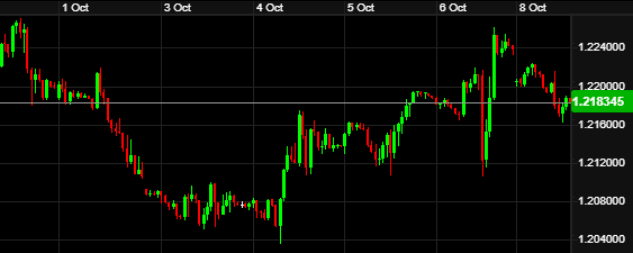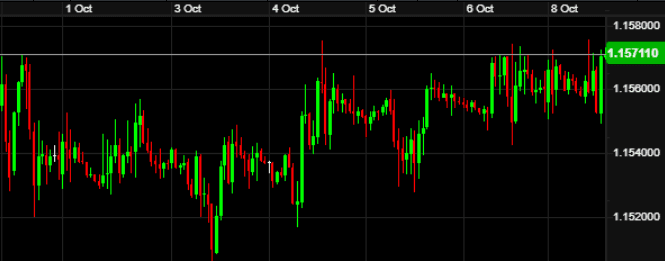ACM Update 09-10-23

Market movements last week were dominated by Jobs data out of the US and their impact on inflation, the wider US economy and thus interest rates. Events in Israel over the weekend though, have understandably impacted rates as we open a new week.
With a week full of bank holidays in various parts of the world, there are a variety of other major events to keep an eye on. We see the latest Federal Reserve meeting minutes released, as well as speeches from Andrew Bailey and Christine Lagarde. The latest in the yo-yoing UK GDP situation will be unveiled too.
As has been the case for a while now, a lot of the movement last week was Dollar-driven. Very little of it came from the rather public in-fighting taking place in the House of Representatives though. Kevin McCarthy was ousted in a 216-210 vote, stabbed in the back by a number of his own party. Then Nancy Pelosi got kicked out of her office by the interim speaker (allegedly), because the former speaker McCarthy decided he wanted it (allegedly). You couldn’t make it up.
In actual economic news, Manufacturing data from the US was better than expected with the ISM figure its best since November 2022 at 49.0. Jobs data was the main order of the week though, with a real mixed picture of results. The JOLTS job openings data was a full 10% better than expected for August at 9.61m. However, the ADP Non-Farm data came in well under expectation at 89k added. This was the lowest since February 2022.
However, the Friday afternoon Non-Farm Payrolls figure almost doubled the expected figure of 171k, posting an impressive 336k. The previous month was also revised considerably higher.
Off the back of this we saw the Dollar gain, then lose about a per cent in the final couple of hours of trading, likely profit-taking before the US bank holiday weekend. The US jobs market running hot may be another factor in US interest rates remaining higher for longer.
As mentioned, events in Israel over the weekend have led to movement in oil prices and therefore FX markets as we start this week. With the current picture, such events could well favour the US Dollar in its safe haven status, at least until the next US debt ceiling situation on 17th November.
Please see below the recent movements in GBP-USD:

On UK soil, the week started off with MPC hawk Catherine Mann speaking about how interest rates are unlikely to return to the low levels experienced pre-pandemic. Not exactly a surprise to anyone!
Meanwhile, many economists came out with predictions about next week’s UK GDP data possibly being the first step towards negative quarterly growth. We will get the first clues on that on Thursday morning, potentially reopening the stagflation topic.
UK Construction PMI data fell off a cliff to 45.0 in September, well into contraction and its lowest since the early stages of COVID in June 2020. Not a good sign for one of the UK economy’s lagged indicators for growth.
Services PMI figures fared better, higher than expected and only just in contraction. For the housing sector, Halifax reported their sixth month in a row of house prices falling, this time by -0.4%.
In the Eurozone, the range of individual Manufacturing PMI releases (Spain/France/Italy/Germany & overall EU) all came in on or above estimate for the first time in a while. The Services PMI followed the same trend. The EU-wide unemployment rate remains at 6.4%, which continues to be an all-time low for the bloc.
In an interview with La Tribune Dimanche over the weekend, Christine Lagarde maintained that CPI growth is still persisting, but is slowing and the ECB “will succeed” in getting it back to 2%. Fingers crossed for her and other central banks that oil prices fall back a shade after recent gains. The situation in Israel and the Middle East will not help this though.
The recent moves (or lack of them) on GBP-EUR are shown below:

Elsewhere we had new RBA Governor Michelle Bullock announce that the bank would keep interest rates on hold for the fourth consecutive month at 4.10%. The post-meeting conference was cautious not to rule out further hikes though. On the other side of the Tasman, rates were held at 5.5% by the Reserve bank of New Zealand also.
This week:
Monday – Japan Bank Holiday, Canada Bank Holiday (Thanksgiving), US Bank Holiday (Columbus Day)
Tuesday – BRC Retail Sales Monitor (00:01 UK time), Fed Member Waller speech (18:00)
Wednesday – US PPI (13:30), Federal Reserve Meeting Minutes (19:00)
Thursday – UK GDP exp 0.2% (07:00), US CPI exp 3.6% & Unemployment Claims (13:30)
Friday – China CPI exp 0.2% (02:30), Andrew Bailey speech (09:00), Christine Lagarde speech (14:00)
All eyes will definitely remain on the events in Israel as we enter this week, and the impact these will have on oil prices. Given the impact the Ukraine invasion had on oil prices and how it continues to directly influence inflation over 18 months on, one would think the US Dollar could well be the main positive mover off the back of this.
Equally, with the US debt ceiling debacle only a week ago being centred around aid to Ukraine, the Eurozone may be forced to lend support at a time when it can ill-afford to.
Once the US Bank Holiday is out of the way on Monday, the latest Federal Reserve meeting minutes on Wednesday will provide clues as to the current thinking of the committee. Albeit the data from just a couple of weeks ago is now well outdated.
With stagnant growth and inflation still running high, the UK economy is still in a difficult position itself. We don’t forecast a drastic change to that picture, barring a substantial upward move in the August GDP numbers, released on Thursday morning. The only possible reprieve was that July was a soggy month of weather, so there may have been a bounce “back” in August.
Speeches from Bank of England Governor, Andrew Bailey, as well as ECB President, Christine Lagarde, close out the week.
Geopolitical movements and fluctuations in commodity prices are likely to be the main drivers this week. Make sure to reach out to the team if you have any requirements, especially Dollar-related.
Have a great week.